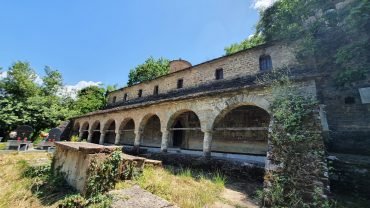Tucked away in the enchanting landscape of southern Albania, Dragoti Bridge is a remarkable piece of architectural and historical heritage that quietly tells the story of a bygone era. Located near the small village of Dragot, in Gjirokastër County, this elegant stone bridge gracefully spans the turquoise waters of the Vjosa River, one of Europe’s last free-flowing wild rivers. A journey to Dragoti Bridge is not just a scenic detour—it’s a step back into the cultural heart of Albania’s rural past.
A Masterpiece of Early 20th Century Stone Architecture
Built in the early 1900s, Dragoti Bridge is a prime example of the craftsmanship of Albanian stonemasons who carried forward Ottoman-influenced architectural traditions. The bridge is constructed entirely from locally sourced stone, skillfully carved and assembled to create a series of graceful arches that stretch across the river. Its symmetrical structure and robust design have withstood the test of time, surviving floods, harsh winters, and the changing tides of history.
The bridge was built not only as a practical crossing but also as a symbol of unity for the communities living on either side of the Vjosa River. In an era when infrastructure was minimal and transportation was often treacherous, bridges like Dragoti were lifelines—connecting villages, enabling trade, and allowing the exchange of culture and tradition between remote areas.
The Bridge and Its Natural Setting
What makes Dragoti Bridge especially captivating is its stunning natural setting. Surrounded by the lush, rugged landscapes of the Vjosa Valley, the area offers spectacular views in every direction. The river below flows freely and unspoiled, making it one of the last wild rivers in Europe. The bridge stands as a perfect vantage point for admiring the untouched beauty of the region—whether it’s the glimmering river currents, the rocky gorges, or the dense greenery that lines the banks.
During spring and summer, the surrounding hills burst into a vibrant tapestry of wildflowers, and the sounds of birdsong and flowing water create a peaceful, almost meditative atmosphere. Many visitors enjoy walking across the bridge to take photos, pause for a moment of reflection, or simply soak in the serenity of the environment.
Cultural Significance and Modern-Day Relevance
While Dragoti Bridge is no longer the primary means of transportation due to the construction of modern roads and infrastructure, it continues to serve as an important cultural and historical monument. Locals take pride in its preservation, and it remains a popular stop for travelers heading to nearby towns such as Tepelena, Përmet, and Gjirokastër.
For those interested in ecotourism and cultural heritage, the bridge represents an important intersection of human ingenuity and environmental harmony. It is often featured in hiking tours and cycling routes through the Vjosa Valley, and many cultural guides include it as a must-see landmark for those exploring the region.
Moreover, the bridge is a part of the ongoing conversation about protecting the Vjosa River and the surrounding ecosystem. Environmentalists and heritage advocates see structures like Dragoti Bridge not only as historical relics but as integral parts of the natural and cultural landscape that must be protected.
A Place of Beauty, Memory, and Connection
In many ways, Dragoti Bridge is more than a piece of stone architecture—it is a symbol of resilience, connection, and beauty. It reflects a time when human structures were built to exist in harmony with nature, and its endurance is a tribute to the skill and vision of those who came before us.
Today, whether you’re a photographer, a history lover, a nature enthusiast, or a curious traveler, a visit to Dragoti Bridge offers a quiet but powerful experience. It’s a reminder of Albania’s rich past, its deep connection to the land, and the timeless bridges—both literal and metaphorical—that continue to shape its future.







Comment (0)